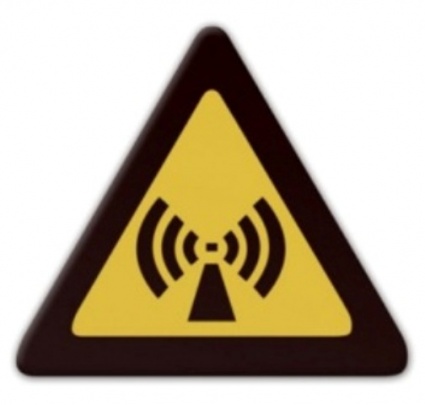April 5, 2012
Health risks of wireless technology, Part 2/4

Health Risks
A National Institutes of Health cell phone study in the American Medical Association (AMA) journal shows that 50 minutes of cell phone radiation increases metabolic activity in the brain.
And a study published online, by the Hardell group, led by Lennart Hardell MD, PhD, Department of Oncology, Orebro Medical Center, Orebro Sweden documents an increased risk in malignant brain tumours linked to cell phone use.
Their sample size consisted of 1,251 cases and 2,438 controls. The highest risk was documented for astrocytomas, a common type of glioma. The most common type of brain tumour at all ages is a glioma. Gliomas consist of glial cells, which form the supportive tissue of the brain. The two major types of glial tumours are astrocytomas and ependymonas.
Authors report an increased risk for brain tumours of 170% with cell phone use and 80% with cordless phone use after 10-years. In a separate analysis the highest risk for astrocytomas was among those who began using mobile phones before the age of 20.
For this group the risk increased by 390% for cell phones and 290% for cordless phones.
The risk for gliomas and mobile phone use increased with latency time and cumulative hours of use, which suggests a dose-response relation that is a part of the Bradford-Hill criteria for causation. The Bradford – Hill criteria outlines the minimal criteria necessary to establish a causal relationship between two items. This criterion forms the basis of modern epidemiological research, which attempts to establish scientifically valid causal connections between potential disease agents and the many diseases that afflict humankind.
The results of this study do not bode well for the young generation of cell phone users. Unfortunately, this radiation permeates our society and those who use a cell phone are contributing to second-hand radiation such that anyone near cell phone antennae is also exposed to this radiation.
The BioInitiative Group (BIG) - a group of leading scientists - is debating why there is 30 years of research indicating adverse effects from exposure to electromagnetic radiation, yet we still have the same standards for acceptable exposure.
After 100 of the world's leading scientists met in Mexico, in 2006, at the Bioelectric Society annual meeting, the BioIniative Group - which grew out of this meeting - prepared the BioIniative Report, which Cindy Sage, Environmental consultant for Sage Consultants, Santa Barbara, CA, said is the only truly independent study of the effects of electromagnetic radiation.
As a result of this report, the BIG is proposing standards of exposure 1000's of times lower than the current standards.
As well as increased risk of brain tumors, Alzheimer’s disease and breast cancer, this study indicates that the immune system may become electrically sensitive, like chemical sensitive.
Ms. Sage said this is a disfunction of the immune system, which is going to result in hugh financial costs to society. Ms. Sage said the consequences of doing nothing are so great we should be doing more now.
Meanwhile is a recent book Wireless Radiation Rescue, by Kerry Crofton, PhD, University of Victoria, bestselling author and cardiologist Stephen T. Sinatra, MD, FACC, warns of wireless radiation risks.
“Electro-pollution (cell phones, Wi-Fi, cordless phones, etc.) is the greatest medical threat of our times,” Mr. Sinatra said.
“We have seen clinical evidence that electro-pollution affects the normal functioning of the electrically sensitive heart, including the rate and rhythm, and other systems of the body ... All forms of pollution impair our health, and the electro-pollution arising from the proliferation of wireless technology has greatly added to this burden.”
Ms. Sage said there has been a massive response to this issue in the European media, but absolute silence in the U.S. (and Canada).
Despite this media coverage, Ms. Sage said the electric utility industry in Australia and almost all telecom organizations lobbying throughout the world, want to either keep the status quo or relax standards in general.
“They want the amount of heat a cell phone can put into your brain to be calculated over 10 grams of tissue, rather than one gram like it is now; and that means you can have higher levels of exposure.”
And she said this comes at a time when the BIG is reporting that we're seeing a rise in brain tumors for people between 13 and 18, after ten years and less of (cell phone) use.
“Everything else that can cause brain tumors – chemical exposure and ionizing radiation – takes ten years for these tumors to show up. Why is it that we're seeing this increase start at ten years or less for cell phone use? Well, it means that cell phones are a very, very effective way to create a brain tumor; and it's happening in half the time.”
She added that many people think it takes a lot of exposure to cell phones to have an increased rate of brain tumors, but the BioInitiative group is beginning to see an increased risk with only 260 lifetime hours of exposure.
“The effect of the increase chance of brain tumors is the highest in young people 20 to 29. In this group there's an eightfold increase of brain cancer for those who started using a cell phone in their teens.”
Moreover, Zhengping Xu, and Guangdi Chen, researchers at the Bioelectromagnetics Laboratory at Zhenjian University, in Hangzhou, China, are finding some effects of microwave radiation on the human genome.
Ms. Sage said we shouldn't be seeing any studies reporting effects on the human genome from accepted levels of exposure, so this means that our standards are not good enough.
“The general conclusion of the BioInitiative Study is that the existing standards we have worldwide for electromagnetics, including power lines, are thousands of times too high. It's inexcusable. If you look at all the scientific studies in the aggregate, the conclusion is that the standards we have do not protect public health.”
The costs to public health will be enormous, if these standards remain in place, Ms. Sage said, particularly for children.
“There's no excuse for exposing children. Their brain and neurological development isn't complete until their early 20's. In schools, wireless internet is popular, but it exposes children through laptops. The exposure a child would get through school – elementary, middle school and high school – is considerable over a lifetime. We really recommend against it now because it's an experiment where we really don't know the health results and it isn't worth it because we don't know the risks. Can we quantify the risks? No, because we're not allowed to do experiments on children.”








